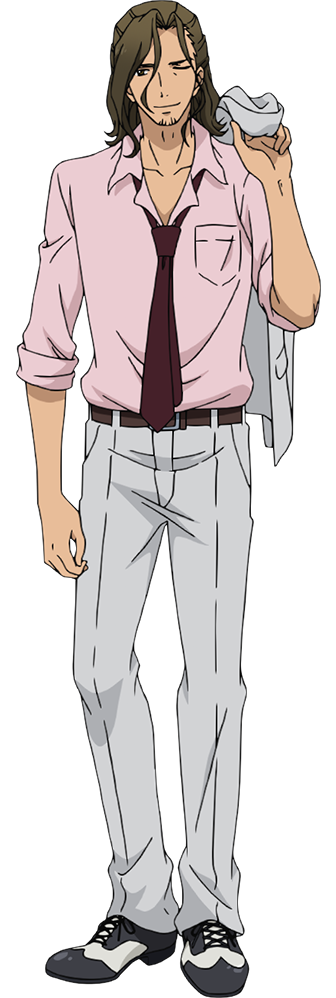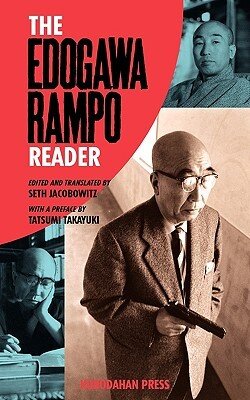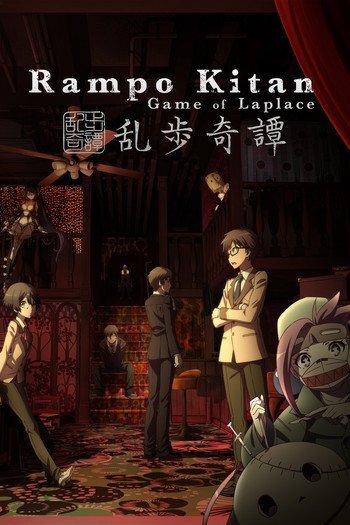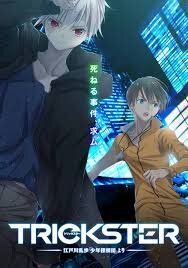Edowaga Ranpo・The Father of Japanese Myster | Author Spotlight
You may have seen the plots from his short stories and novels in countless books, mangas, animations, TV shows, and movies adaptations, but didn't know they are all created or inspired by him. He's one of the first writers who started to write mystery novels in Japan. He established the modern mystery genre in Japan and started the prosperity of Japanese detective fiction. He's called the father of Japanese Mystery, and the most authoritative award for Japanese mystery writers is named after him. He is Edogawa Ranpo, 江戸川 乱歩.
Akechi Kogorō, a character in manga Trickster, referencing the most popular detective in Ranpo’s work.
Deeply influenced by western mystery stories, Tarō Hirai took the romaji version of the name, Edgar Allan Poe, as his pseudonym, and built his legacy with the name Edogawa Ranpo. Besides Poe, Ranpo was also influenced by Sir Arthur Conan Doyle, he created The Boy Detective Club as helpers to his iconic detective Akechi Kogorō, paying tribute to Baker Street Irregulars in the Sherlock Holmes series.
Edogawa Ranpo started as a short story writer because he believed that short stories are the epic format of mysteries. But one other reason may be because, at his time, most writings are published in the newspaper, so it's harder to publish longer works, since newspaper serials will break the continuity of novels, and it's also not profitable. After his initial attempt for traditional "whodunit" novels, he started to show his personality in his works. Peculiar storytelling, brutal and eroticism often have places in his work during his most active period. But during and after the Second World War, he started to shift his audiences to a younger age range, created teenage detective stories, which gained fame for his character, Akechi Kogorō, and made him an even more notable writer.
Edogawa Ranpo is one of my favorite mystery writers of all time. Some of his works are quirky, funny, and delightful, For example, his Boy Detective Club series. Some of his works are dark, eerie, and unique, like the Strange Tale of Panorama Island.
His ability to write a wide variety of stories always amused me. And when I’m tired from a busy day, it’s always delightful to pick up one of Ranpo’s books before bed.
Legacy
Ranpo is the first president of the organization, Mystery Writers of Japan/日本推理作家協会, which presents award to honor the best in crime fiction and critical/biographical work published in the previous year since 1948, called Mystery Writers of Japan Award/日本推理作家協会賞.
The award to amateur mystery writers who had few or no novels published commercially since 1955, Edogawa Rampo Prize*/ 江戸川乱歩賞, was named after him.
Notable works of Ranpo that have English translations.
The Early Cases of Akechi Kogoro
Translated by William Varteresian
This is a collection of early Ranpo works. His iconic detective Akechi Kogorō was first introduced to readers in the story *The Case of the Murder on D. Hill*. With messy hair and related personality, Kogorō solved the locked-room murder in a second-hand bookshop and started his detective career. By then, he lived in a tiny one-room apartment in Tokyo and claimed that he likes to study humans.
In this collection, Ranpo was focusing on traditional mystery writing, solving the classical crime tactics. He rarely writes about Akechi Kogorō's personal information, made him a detached character from the fictional world. But later on, we can see Ranpo paid more attention to the story and background of Kogorō when he decided to create novels around him and make him a well-established character.
Japanese Tales of Mystery and Imagination
Translated by James B. Harris
In this short story collection, we don't see Akechi Kogorō, as the stories took a turn from classical stories, to a peculiar twisting way. Imagination is the keyword throughout this collection. A lot of environmental description is abstract. For example in the story *The Traveler with the Pasted Rag Picture,* the narrator was taking a train by the sea. But the ocean was oddly still, no waves, no ships. not a single sign of living. The color of the ocean was dull too, made it looks like a swamp that extended into the sky.
The other story The Human Chair started with a strange letter that makes people chill. It's from an admirer to a well-known writer. The letter didn't have the address of the sender and started with "Mrs." instead of Sensei, which is normally used to address writers in Japanese. And the letter described the chair in the writer's office, detailed enough to give the writer chills.
Strange Tale of Panorama Island
Translated by Elaine Kazu Gerbert
Written in the year when Ranpo published the largest amount of work, *Strange Tale of Panorama Island* is one of Ranpo's most peculiar works. A failed novelist Hitomi found out he may have the chance to turn an island into the Utopia of his dream. This story is a product of the quirkiest imagination met the weirdest illusion. Mixed in with the bizarre settings of the story, is a crime case that happened on the island where Ranpo showed off his mystery writings.
Ranpo was doubting his creativity in writing when he was writing this novel, he didn't have much confidence of this work until he heard the praise of it from poet Hagiwara Sakutarō (萩原朔太郎). Lacking confidence in writing sometimes bothers Ranpo and even stops him from creating from time to time. But he often goes on after getting affirmed by other established writers, hence this novel.
Moju: The Blind Beast
Translated by Anthony Whyte
This book is one of the most brutal and bloody works of Ranpo, a representation of "ero guro nansennsu" style, shorten for "eroticism, grotesquerie and nonsensical". These works were written before Ranpo started to write lighter novels. The story The Blind Beast started with a model being captured by a sculptor. Pages full of violence and eroticism, a style developed from earlier work Stange Tales of Panorama Island.
The Black Lizard and Beast in the Shadows
Translated by Ian Hughes
This book contains the two novellas of Ranpo's. The Black Lizard features detective Akechi Kogorõ. Different from previous work where Kogorō mainly focused on solving mysteries by observing and elementary, here in The Black Lizard he became a master in action, chasing his opponent in the fast-paced story. In this story, we can't find the odd and twisting writing that Ranpo usually has, the approach of the story is very positive. This can be seen as the turn where Ranpo decided to put Kogorō as the main character of The Detective Boys series, a series towards teenager audience.
Beast in the Shadow was written after Ranpo decided to quit writing in 1927. He re-debut in the summer of 1928 with Beast in the Shadow which has drawn rave reviews from critiques and readers. In this story, there are only three characters. Two mystery writers each got part of Akechi Kogorō's name, and the third character is a lady who became friends with the mystery writers. This is an absurd queer novel that gains back some confidence in writing for Ranpo.
The Edogawa Rampo Reader
Translated by Seth Jacobowitz
This is a collection of new translated Ranpo's work (in 2008), these are outstanding short stories and non-fiction prose throughout his entire writing career, from the 1920s to the 1950s. They represent a full picture of Ranpo's legacy. It's a good introduction to Ranpo's world to English readers.
Books in The Detective Boys series
The Fiend with Twenty Faces
Translated by Dan Luffrey
This is the first installment of the Boy Detective Club series, which features our beloved detective Akechi Kogorō, and his helpers, the boy detective club led by Kobayashi Yoshio (小林芳雄), his apprentice. 怪人二十面相, The Fiend with Twenty Faces, is Kogorō's archenemy. He appeared in this book the first time as a gentleman theif and a master of disguise. This is a book where Kogorō became extremely popular and left a great impact on the Japanese fictional world. Numerous other fictional works had referenced either Kogorō, the boy detective club, or the fiend with twenty faces.
This series was written in another slump of Ranpo's work. Despite it was written for a younger audience, the bright style of storytelling and the intense mystery and actions got surprisedly positive reviews, made this series a delightful read for readers of all ages.
Notable References of Ranpo’s work and characters
名探偵コナン/ Detective Conan is one of the most popular manga and anime series that referencing Ranpo’s work in multiple ways. And it’s my favorite anime of all time.
Detective Conan/ 名探偵コナン
The main character Edogawa Conan’s name is a combaination of Edogawa Conan and Sir Arthur Conan Doyle.
Mouri Kogorō, one of the main detective’s is named after Ranpo’s detective, Akechi Kogorō.
The Boy Detective Club (a group of Conan’s friends) plays an important role in the story.
And also there’s a legendary thief in this series that mirroring the Fiend with Twenty Faces.
Other works
*Edogawa Ranpo’s English name is referenced differently in different sources. “Rampo” is true to the English pronunciation. “Ranpo” is true to the Kana of his name’s Japanese pronunciation. Here I use “Ranpo” most of the time, except for Edogawa Rampo Prize and The Edogawa Rampo Reader, since they both used “Rampo” at the first place.














